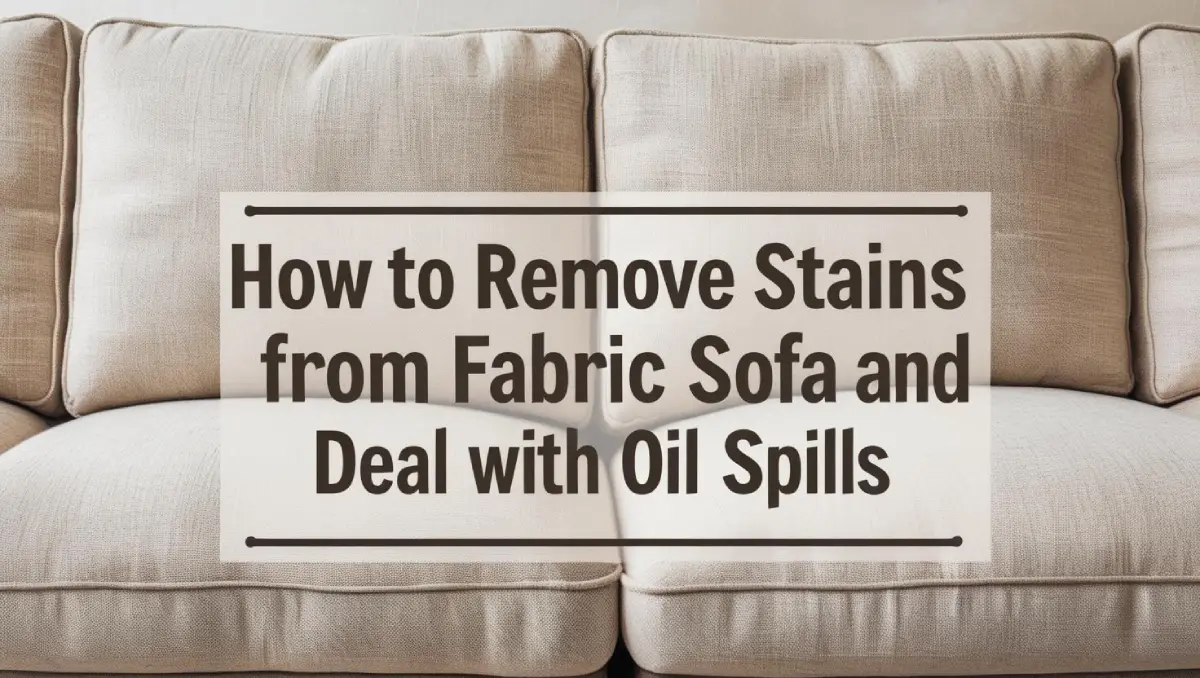Your fabric sofa is a central part of your home—it’s where you relax, host guests, watch movies, or even take quick naps. Unfortunately, it’s also where spills, smudges, and stains tend to happen the most. Whether it’s a splash of wine, muddy paw prints, or a greasy food spill, knowing how to remove stains from fabric sofa surfaces can save your furniture and your peace of mind.
One of the most dreaded types of mess? Oil stains. They’re tricky and stubborn and, if left untreated, can leave dark patches that seem impossible to remove. If you’re wondering how to get oil out of sofa cushions or covers, this guide has you covered.

Why Fabric Sofas Are Prone to Stains?
Fabric upholstery is cosy and stylish, but its porous nature makes it especially vulnerable to absorbing liquids and grime. Unlike leather or synthetic materials, fabric doesn’t repel moisture—it soaks it in. This means that stains settle quickly and can become permanent if not addressed immediately.
Fabric sofas are also made from a variety of materials, including cotton, linen, polyester, microfiber, and blends. Each fabric has its own tolerance to water, solvents, and cleaning agents, which is why identifying your sofa’s cleaning code is essential before you begin stain removal.
Understanding Sofa Cleaning Codes
Check the manufacturer’s label for a cleaning code. This simple letter tells you what types of cleaners are safe to use:
-
W – Use water-based cleaners
-
S – Use solvent-based cleaners only
-
WS – Water- or solvent-based cleaners are safe
-
X – Vacuum only; no liquids
Following these codes ensures that you won’t damage the fabric further while cleaning.
How to Remove Stains from a Fabric Sofa? A Step-by-Step Guide
Step 1: Blot, Don’t Rub
For any fresh stain—whether it’s juice, wine, or coffee—the first step is to blot. Use a clean white cloth or paper towel to gently press into the stained area. Rubbing will push the stain deeper into the fibers, making it harder to remove.
Step 2: Apply a Cleaning Solution
Depending on the type of stain, different solutions may work best:
-
Water-Based Stains (e.g., soda, coffee, wine):
Mix one cup of lukewarm water with a tablespoon of mild dish soap. Dampen a microfiber cloth and blot the stain, working from the outside in. -
Protein-Based Stains (e.g., blood, milk):
Use cold water and a bit of baking soda or enzymatic cleaner to break down the proteins. -
Ink or Dye Stains:
Apply a small amount of isopropyl alcohol to a cotton ball and gently dab the stain. Test in an inconspicuous area first to ensure it doesn’t affect the colour. -
General Stains:
A solution of white vinegar and water (50/50) works well for neutralising odours and removing discoloration.
After applying the cleaner, blot with a damp cloth to remove residue, then let the area air dry completely.
How to Get Oil Out of Sofa Fabric?
Now let’s tackle one of the most frustrating problems: how to get oil out of sofa upholstery. Oil from food, skin, or hair products can leave noticeable marks, especially on light-coloured fabric.
Step 1: Absorb Excess Oil
If the stain is fresh, blot the area with a paper towel to soak up as much oil as possible. Don’t rub—it can push the oil further into the fabric.
Step 2: Apply an Absorbent Powder
Sprinkle baking soda, cornflour, or talcum powder generously over the stain. Let it sit for at least 15–30 minutes to absorb the oil. For older stains, leave it overnight.
Step 3: Vacuum or Brush Off
After the powder has absorbed the oil, gently brush or vacuum it away. You’ll likely notice that some of the stain has lifted already.
Step 4: Use a Dish Soap Solution
Mix a small amount of dishwashing liquid (which cuts grease) with warm water. Using a cloth, dab the stained area with the soapy solution and blot to lift the oil.
Repeat as necessary, and blot with a clean, damp cloth afterwards to rinse away any soap residue.
Dealing with Set-In or Old Stains
Old stains require a bit more effort. You may need to repeat the cleaning process a few times or use a commercial upholstery cleaner that’s safe for your fabric type.
For deeply embedded stains, professional steam cleaning or dry cleaning might be the best option. If you’ve tried multiple methods and the stain remains, hiring a professional can restore your sofa to near-new condition without risking damage.
Natural DIY Cleaners for Fabric Sofas
If you prefer natural cleaning methods, here are a few homemade solutions:
-
Vinegar + Baking Soda Paste: Great for neutralising odours and lifting stains.
-
Hydrogen Peroxide (for light fabrics only): Mix with a bit of dish soap to remove tough stains.
-
Lemon Juice + Salt: Works on some food and beverage stains, but test first to avoid discoloration.
Always test in a hidden area first to ensure it doesn’t bleach or damage the fabric.
Prevention Tips for a Spotless Sofa
To avoid frequent cleaning, consider these prevention tips:
-
Use washable slipcovers or armrest protectors
-
Vacuum regularly to remove crumbs, pet hair, and dust
-
Apply a fabric protector spray like Scotchgard to repel stains
-
Clean spills immediately before they have time to settle
-
Rotate cushions regularly to ensure even wear
By following these tips, you’ll extend the life of your sofa and reduce the need for deep cleaning.
When to Call a Professional?
If you’re unsure about the type of stain, fabric, or cleaner to use—or if your DIY efforts aren’t working—it may be time to call in the pros. Professional upholstery cleaners use tools like hot water extraction and steam cleaning to deep-clean fabric safely and effectively.
They’re especially useful if:
-
The sofa is made of delicate or expensive materials
-
The stain has soaked through to the cushion or base
-
There’s a persistent odor (especially from pet urine or oil)
-
Mold or mildew is present
Final Thoughts
Learning how to remove stains from fabric sofa surfaces isn’t just about keeping your home looking clean—it’s about protecting your investment and maintaining a healthy living environment. And when it comes to grease or food-related mishaps, knowing how to get oil out of sofa upholstery can make the difference between a permanent eyesore and a fully restored couch.
With the right techniques, a little patience, and a consistent cleaning routine, your fabric sofa can look great and serve you for many years to come.

